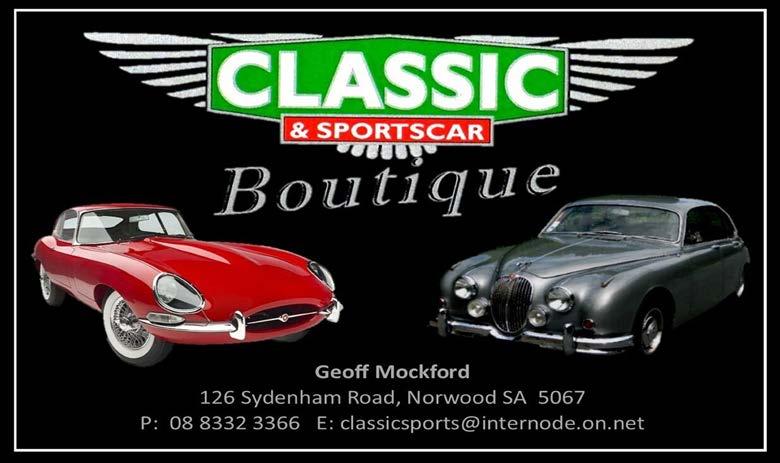
26 minute read
CONTENTS (Feature Articles) Jaguar Anniversaries
Editor - 2021 represents a number of milestones in Jaguars history. Most are aware of the 60th Jubilee of the celebrated E-Type, but other Jaguar models and individuals will also be celebrating an anniversary this year.
Sir William Lyons. (Born 1901)
Known as “Mr. Jaguar”, Sir William, was with fellow motorcycle enthusiast William Walmsley, the co-founder in 1922 of the Swallow Sidecar Company. Lyons took this sidecar manufacturing business and developed it into a prominent World-wide Company in just a matter of a few years. Lyons is still remembered as Jaguar; these two are synonymous. Although he died in 1985 his legacy is still regarded highly by the current Design Department at Jaguar. Indeed, Ian Callum, Director of Design from 1999 to 2019, often looked at past Jaguar models to keep the ‘LyonsJaguar DNA’ alive. How did Lyons exert such an influence on a brand? He was a charismatic person, single-minded and certainly strongwilled. Tremendously hard-working, Lyons expected his staff to do likewise. He surrounded himself with exceptionally talented people who were just as keen on the enterprise as he was. The first “Jaguar” model was offered in 1935, and after World War II, Lyons changed the company name to Jaguar to avoid the unfortunate connotations with the Nazi SS “Schutzstaffel”. Armstrong Siddeley allowed Lyons to use the Jaguar name from their successful aircraft engine range, such was the camaraderie of the car industry at the time. As managing director of Jaguar, Lyons could be best described as ‘autocratic’ and kept a tight rein on the company. It is said that board meetings were rare until the 1960s. He was responsible for the styling of every new model introduced (although the C-type, D-type, E-type and XJ-S were designed by Malcolm Sayer). This was remarkable, as Sir William was not a trained engineer, and designed primarily using full scale 3-D mockups, which were continually adjusted by craftsmen working under his instructions. Later years In 1956, Lyons was knighted for his services to British industry and for the fine export performance of the company. In 1966, faced with a strengthening global industry, he merged Jaguar with the British Motor Corporation (BMC) to form British Motor Holdings, which was later absorbed into British Leyland. Unfortunately, the final years of Lyons tenure before he retired as managing director near the end of 1967, while remaining on as chairman, were a constant struggle against impossible odds to retain the identity and independence of his company, not least its engineering department. He retired completely to Wappenbury Hall in 1972, to play golf, travel, garden, and keep prize-winning Suffolk sheep and Jersey cattle on his farm estates at Wappenbury. His health declined fairly rapidly in retirement and the reemergence of his company under John Egan took place after his death in 1985. Despite this, Lyons remained in a consultative role to Jaguar until shortly before his death, and had participated in the styling of both the Jaguar XJS and Jaguar XJ40 during his retirement. .
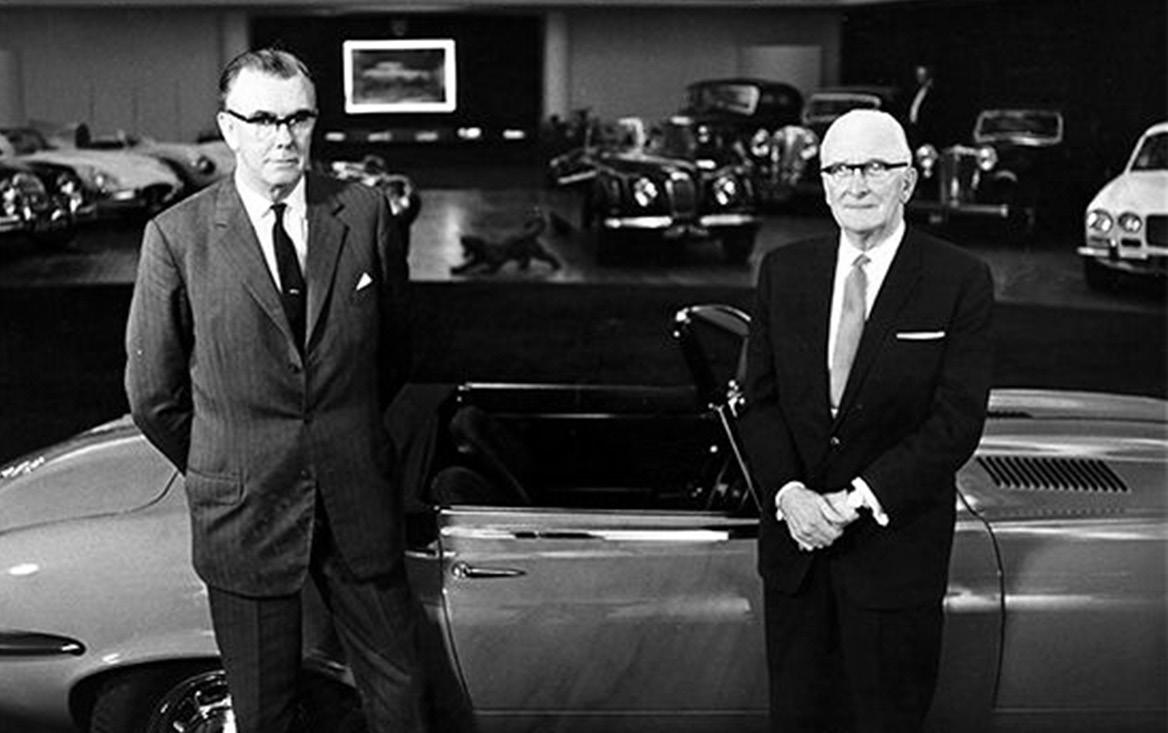
Lofty England (Born 1911)
Frank Raymond Wilton “Lofty” England (24 August 1911–30 May 1995) was a race engineer, team manager, Service Manager and Chairman of Jaguar Cars. Early Life England was apprenticed as an engineer to the Daimler Company in 1927. Owing to his 6’ 5” height, he quickly acquired the nickname, “Lofty”, which would stick with him for the rest of his life. Throughout the 1930’s he worked as a race engineer for various teams including ERA and Alvis before volunteering and joining the RAF as a bombardier during WW2.
Post-war Jaguar motorsport Through close friend and engineer Walter Hassan, Lofty secured a move to Jaguar Cars in early 1946 as Service Manager and then Manager of the Jaguar Cars Sports Car Racing Team. He recognised the potency of the XK engine, and lead the development of the C-Type racing car. Lofty racing experience and sharp strategic thinking resulted in a striking victory over 19 cars with engines larger than the C-Type’s, to win the 1951 Le Mans 24 hour race. But there was more come. During the 1950’s Jaguar cars won the prestigious 24 Hours of Le Mans race on five occasions. Lofty England’s contribution to Jaguars racing success was crucial. He ran the team, always with an eye for the greater good of Jaguar, rather than the individual demands of any one driver. After the company’s withdrawal from racing, England moved into the mainstream management of Jaguar Cars, later succeeding Sir William Lyons as its chairman and Chief Executive, before retiring in 1974. Following his retirement, although he had no direct involvement with the company, England always maintained an interest in Jaguar’s fortunes.

Lofty England and Jaguar racing driver Mike Hawthorn were great friends. Mike was guest speaker at a Jaguar function in 1956, at which he was presented with a D-type steering wheel by Lofty. In 2005 a sculpture was unveiled at Goodwood Race Track, as a tribute to both of them, with Lofty carrying a D-type steering wheel.
Jaguar Anniversary: SS 100 (1936)
SS Jaguar 100 (1st built 85 years ago)
The SS Jaguar 100 is 2-seat sports car built between 1936 and 1939 by SS Cars Ltd of Coventry, England. The ‘100’ was for the theoretical 100 mph maximum speed of the vehicle which on a test by Autocar magazine was achieved by a 3½-litre model (101 mph over the quarter mile). The chassis was essentially a shortened version of the one designed for the 2½-litre saloon. The engine was a development of the old 2½-litre Standard pushrod unit converted from side valve to overhead valve with a new cylinder head designed by William Heynes and Harry Weslake. In 1938 the engine was further enlarged to 3½ litres and the power increased to 125 bhp (93 kW). The four-speed gearbox had synchromesh on the top 3 ratios. The mechanical brakes were by Girling. The complete cars weighed just over 1150 kg. It was on an SS100 that the famous Jaguar ‘leaper’, the marque’s signature feline bonnet ornament, was first displayed. Considered one of the most aesthetically pleasing sports cars of the 1930s the SS100 is rare, with only 198 2½-litre and 116 3½-litre models made. While most stayed in the UK, 49 were exported overseas including 4 to Australia. In 2010 at an auction in Pebble Beach a restored former Pebble Beach concours winning 1937 S.S. Jaguar 100 3½ Litre roadster was sold for a noteworthy £666,270 (A$1.20m).
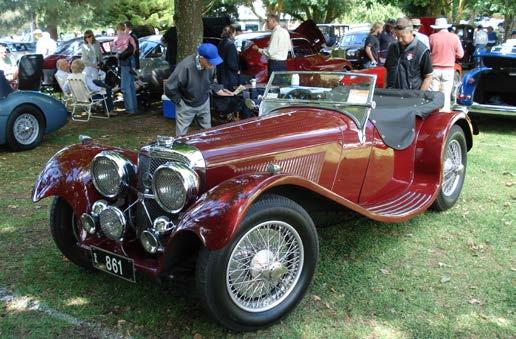
1951 C-Type (Celebrating 70 years)
The Jaguar C-Type was first built in 1951, 70 years ago. The “C” stands for “competition” and was officially called the Jaguar XK120-C as a commercial move to boost sales of the XK120 model as a result of the C-Type competition results. The C-Type used the XK 120 running gear of the contemporary road proven XK120 in a lightweight tubular frame designed by Jaguar Chief Engineer William Heynes with an aerodynamic aluminium body jointly developed by William Heynes, R J (Bob) Knight and later Malcolm Sayer. A total of 53 C-Types were built, 43 of which were sold to private owners mainly in the US. The C-Type version was originally tuned to around 205 bhp. The early C-Types were fitted with twin SU carburettors and drum brakes. Later C-Types (mid 1953) were more powerful, using triple Weber carburettors, high-lift camshafts, lighter bodies and disc brakes on all four wheels. According to the Jaguar Heritage Registry, the cars were produced between May 1951 starting with XKC001 and ending August 1953 XK054. The C-Type was very successful in racing, most notably at the Le Mans 24 hours race, which it won twice in 1951 (Peter Walker and Peter Whitehead) and in 1953 by Duncan Hamilton and Tony Rolt who won the race at 105.85 mph, the first time Le Mans had been won at an average of over 100 miles per hour.

Val Weeks in the ex Gavin-Sandford-Morgan, ex John Blanden Ecurie Ecosse C-Type Jaguar. The XK120-C’s were designed by Malcolm Sayer, but Lyons required the addition of a grille similar to the XK120 to align the C-Type with the road going car (and assist sales).
Jaguar Anniversary: Mark VII (1951)
1951 Mark VII (Celebrating 70 years)
The Jaguar Mark VII luxury saloon first went on sale in 1951, 70 years ago. In its original 1951 form the Mark VII could exceed 100 mph, and in 1952 it became the first Jaguar to be made available with an optional automatic transmission. Whereas the Mark V had a pre-war pushrod engine originally developed by the Standard Motor Company, the Mark VII was powered by the newly developed 3.5 litre XK engine, first seen in production form in the 1948 XK120. The Big Cat’s first significant upgrade came in 1953 when telescopic shock absorbers replaced lever action units and the optional two-speed automatic became a three-speed auto. Though a large car, the Mark VII was raced extensively and successfully. It was the touring car racer of choice back in the day, having been raced by, among others, Stirling Moss and later F1 champion Mike Hawthorne. Mark VII’s were never beaten in the Silverstone Daily Express one-hour Trophy Production Touring Car race, winning 5 years running. The Mark VII also proved to be a very effective rally car with Irishman Ronnie Adams winning the Monte Carlo Rally in 1956. The Mk VII shape with upgrades and detail changes lasted 10 years and was an important modern limousine to offer alongside the compact Jaguars. Of the 30,969 Mark VII’s produced, a surprising number have survived, especially in Australia.

1961 E-Type (Celebrating 60 years)
Jaguar designer Malcolm Sayer achieved something unique with the E-type, and even now the car remains a symbol of motoring’s finest hour. From the very beginning, the E-type has held a mystique that few other manufacturers’ cars could match. That the performance and handling matched the exquisite shape only underlined the masterpiece of design. Far better on the road than either of its contemporaries, Aston Martin or Ferrari, it lacked the temperamental frailties of the more exotic counterparts, and a Ferrari cost three times that of the Jaguar. Evolving through three series with three different body styles, there was an E-type for every occasion, and when production ended in 1974, some 75,000 examples had rolled off the production line. Collectability As incredible as it now sounds, but there was a brief period in the 70’s & 80’s when the E-type was unloved. However, it is estimated that around 50,000 of the 75,000 cars are still on the roads (or in collections). As the cost to restore an E-type continues to rise, so does the sale price of the restored vehicle. The six-figure sum required for either the purchase of a decent car or restoration costs are just the start. New York Museum of Modern Art One of the first cultural institutions to recognise the E-type’s wider importance, MOMA acquired a 1963 roadster in 1996. At the time, it was only the third car to make it into the hallowed halls. It is still hard to believe that the first E-Types are 60 years old!

On its release on 15 March 1961 Enzo Ferrari called it “the most beautiful car ever made”. In March 2008, the Jaguar E-Type ranked number 1 in The Daily Telegraph online list of the worlds “100 most beautiful cars” of all time. Ownership is never dull.
Jaguar Anniversary: Mark X (1961)
1961 Mark X (Celebrating 60 years)
The Jaguar Mark X (Mark ten), later renamed the Jaguar 420G, was Jaguar’s top-of-the-range saloon car for a decade, from 1961 to 1970. The large, luxurious Mark X succeeded the Mark IX as the company’s top saloon model, and was primarily aimed at the United States market.
Nothing prepared us for the Mark X. This 1892kg behemoth was almost 90kg heavier than its Mark IX predecessor, 14cm longer, 8cm wider and an extraordinary 22cm lower. Jaguar didn’t build another car as large as the Mark X / 420G for the rest of the century, until the LWB version of the 2003 XJ (X350). Beneath its voluptuous curves, the Mark X was a very advanced machine. Its rear suspension was per the E-Type’s. This was an elaborate monocoque with the rear suspension, transmission and propeller shaft mounted on an auxiliary chassis frame. As on the E-Type, inboard rear disc brakes were fitted. In 1964 the torquier 4.2-litre version replaced the 3.8 and this made the Mark X more responsive.
Reviews
Magazines at the time praised the car and noted that the main impression on taking the wheel of the Mk X was its impressively quiet running allied to tremendous performance with almost sports car stability through fast bends.
Value for Money
In the luxury car market, the Mk X/420G was competitively priced at less than half the price of the contemporary RollsRoyce Silver Cloud.
Collectability
Despite outstanding driveability, the Mark X never hit the spot with collectors. That is now beginning to change.

1966 XJ13 (Celebrating 55 years)
The Jaguar XJ13 was a prototype racing car developed by Jaguar Engineering Director William Heynes to compete at Le Mans in the mid-1960s. It never raced, and only one was produced. The design structure of a mid-engined prototype was first mooted in 1960 by Heynes, but it was not until 1965 that construction began, with the car running by March 1966. The engine design was essentially two XK 6-cylinder engines on a common crankshaft with an aluminium cylinder block and quad overhead camshafts. The first engine ran in July 1964. Accident In 1971 the Series 3 E-type was about to be launched with Jaguar’s first production V12 engine. The publicity team wanted a shot of the XJ13 at speed for the opening sequence of the film launching the V12 E-Type. On 21 January 1971, the XJ13 was taken to MIRA for the filming with Jaguar test driver Norman Dewis at the wheel. Sadly, the car was driven by Dewis at speed on a damaged tyre, against the instructions of Jaguar director “Lofty” England. The resultant crash heavily damaged and nearly destroyed the car, although Dewis was unharmed. The car wreck was put back into storage. Rebuild Some years later, Edward Loades spotted the crashed XJ13 in storage at Jaguar and made the offer to ‘Lofty’ England that his company “Abbey Panels” could repair the car. The car was rebuilt, to a specification similar to the original, using some of the body jigs made for its original construction. It is now displayed at the British Motor Museum at Gaydon, UK.

Ex Collin Sutton XJ13 replica. The original XJ13 was built to race at LeMans but never did.
Jaguar Anniversary: 420 (1966)
Jaguar 420/Daimler Sovereign 420
The Jaguar 420 and its Daimler Sovereign equivalent were introduced 55 years ago in October 1966 at the London Motor Show. The 420 was produced until 1968 and the Daimler continued until 1969. Developed from the Jaguar S-Type, the 420 was a stopgap model due to the protracted development of the radically new XJ6. Sir William therefore decided to build a face-lift of the S-type using the newly modified 4.2 litre engine. There was an almost caricature element to the way the 420 seemed to combine the amidships section of the Mark 2 with the nose and tail sections of the Mark X. However, the 420 was far superior to the Mark 2 and S-Type from which it was distantly derived. Engine The 420/Sovereign was fitted with the same 4.2-litre XK engine as the E-Type using a straight port cylinder head and 3/8-inch lift cams. Although the engine was fed by just two carburettors, it developed only 20 bhp less than the triple-carburettor version in the 420G and E-Type. The 420 was also lowgeared, meaning it was quicker off the line but still capable of over 120 mph. Interior The 420 had plusher seats than either the Mark 2 or S-Type with individual pulldown armrests for the front occupants. The Daimler Sovereign was offered with all the 420 extras as standard and differed in badging and detail. They had more carefully selected walnut veneer trim, higher grade leather seat centre sections and better-quality sun visors. You can buy a pristine 420 for roughly one-third the price of a 3.8 litre Mark 2 manual.

V12 Engine (Celebrating 50 years)
The V12 was in production from 1971 to 1997, during which time a total of 161,583 V12-engined cars were made. This engine powered four generations of Jaguar saloons, from the XJ12 Series 1 through the S2 and S3 models, to the XJ(XJ40) and XJ(X305). The V12 was also found in the E-type Series 3 from 1971 to 1974, and in the XJ-S from 1975 to 1996. The all-aluminium block was fitted with single overhead camshaft aluminium heads with two valves per cylinder.

Original flat head and the May “Fireball” head that helped improve fuel economy.
The first engines were fitted with four Stromberg carburettors but gave way to a Bosch fuel-injection system in 1973 and later a Bosch-Bendix-Lucas variant. The HE (High Efficiency) cylinder heads arrived in 1981. These engines used special high-swirl design cylinder heads designed by Swiss engineer Michael May. These “Fireball” heads allowed the engine to run at an unusually high compression ratio (for the time) while running a relatively lean fuel mixture. This in turn significantly improved fuel economy. 6.0 Litre V12 The V12 was finally enlarged to 6 litres in 1993, although TWR were using an upgraded engine in their production XJ-S cars (XJRS’s) with a 6.0 litre (5,993 cc) version of the V12, which pre-dated the Jaguar production version by 3 years. The Jaguar V12 engine was the first modern V12 engine in mass production, and at the time the V12 engine was regarded as one of the premier power plants of the 1970s and 1980s. The V12 engine was also the basis of the racing engines that brought Jaguar victory at Le Mans in 1988 and 1990. The last Jaguar V12 engine was produced on 17 April 1997.


1971 (5.3L) & 1994 (6.0L) V12 engine. Overtime the engine and accessories were “tidied up” and made significantly neater.
Jaguar Anniversary: E-Type Series 3 (1971)
E-Type S3 (Celebrating 50 years)
The Series 3 was introduced in 1971, with the new 5.3 L Jaguar V12 engine, up-rated brakes, and power steering. The short wheelbase FHC body style was discontinued, with the Series 3 available only as a convertible and 2+2 coupé. Options available included automatic transmission, wire wheels and air conditioning. The newly used longer wheelbase now offered significantly more room in all directions. The Series 3 is easily identifiable by the large cross-slatted front grille, flared wheel arches, wider tyres, four exhaust tips and a badge on the rear that proclaims it to be a V12. Cars for the US market were fitted with large projecting rubber bumper overriders. In 1973 these were on the front and in 1974 they were fitted to both the front and rear to meet local 5 mph (8 km/h) impact regulations. Those fitted on European models were smaller. Production of the E-type came to an end in June 1974 with a special run of fifty cars. Forty-nine of these were painted black, while the second last car was British Racing Green and was supplied to a private Jaguar collector. These fifty cars carried a commemorative plaque, bearing a facsimile of Sir William Lyons’s signature.


Robbie Williams has had several Jaguars including a 3.8 litre E-type, a Modern S-Type and this 1975 Series 3.
XJ40 (1st built 35 years ago)
The XJ40 was first all-new Jaguar saloon since the introduction of the XJ6 in 1968. Introduced at the 1986 Motor Show it featured a new engine family, state of the art electronic technology, and the new unique Jaguar J-gate automatic transmission operation. The all-new body had significantly improved build methods over previous models, but its angular styling and six-light design were a break with Jaguar traditions, A new Jaguar saloon under the code number XJ40 had been proposed as early as 1972, with many different ideas being examined. The final styling proposal was adopted by 1980. It was quite the longest development programme in Jaguar’s history, and the new car was also the most stringently tested model that Jaguar had produced up to that time, with 250 prototypes and development cars covering over five million miles. The XJ40 was powered by the AJ6 sixcylinder engine, which had been in small-scale production for the XJS since 1983. With the XJ40, the AJ6 replaced the classic XK engine in Jaguar’s saloon range. In addition to the original 3.6 litre AJ6, there was now a single overhead camshaft 2.9 litre version. These engines were later upgraded to 3.2 litres and 4 litres respectively. The original model range consisted of XJ6 and Sovereign versions with both engine sizes, and a Daimler 3.6 litre. Originally the XJ40 had not been designed to accept the V12 engine, but eventually a 6-litre XJ12 appeared in 1993. The XJ40 was replaced by the muchrevised X300 which marked a return from the angular styling of the XJ40 to a more traditional Jaguar look.

Roland Donders 1990 Daimler. This car is an XJ40 Update model featuring analog gauges and the 4.0 litre motor.
Jaguar Anniversary: X-Type (2001)
X-Type 2001 (Celebrating 20 years)
In the new millennium small executives had become the rage, and so in March 2001 Jaguar launched its most ambitious car, a new compact executive saloon. The problem was that Jaguar did not have a competitive platform. Therefore, the X-type used a modified version of the front-drive Ford CD132 platform with the addition of all-wheel drive. The X-Type took the greatest number of design cues from the XJ, mostly the forthcoming X350. However, in order to find its own identity, the X-Type used smaller, elliptical headlamps to widen the appearance and appear sleeker, being too tall and narrow at the front to pull off the XJ’s traditional front. The design of its wide radiator grille and quad-headlights worked beautifully and, like other Jaguars, the X-Type has the look of an athletic cat. Inside there was traditional leather-and-timber interiors. The X-Type broke new ground in that it was Jaguar’s: • first station wagon/estate car, • would ultimately introduce Jaguar’s first diesel engine, • introduced Jaguar’s first four-cylinder engine since 1949 and • became Jaguar’s first front-wheel and all-wheel drive configuration. In December 2009, the last X-Type rolled off the production line. At the time, with no direct replacement, JLR sacrificed its footing in the small luxury executive saloon and estate marketplace.

XK8/XKR (Celebrating 25 years) When the XK first appeared to the world back in 1996 it created a whole new era for the history of Jaguar’s sports cars.
When the XK8 made its debut, with its smooth, slim lines so reminiscent of the E-type, it was clear that Jaguar was heading back to its roots following 21 years of the angular XJ-S. The car was more than simply looking back because under the bonnet was an all-new, 4.0-litre multivalve V8 that with 290bhp, resulted in a stronger performance than the XJS 4.0L. The XKR was made stronger still by the addition of an Eaton supercharger, when an extra 80bhp gave the XKR almost Supercar performance. The platform for the XK series was derived from its predecessor, the XJ-S. From the start the car was available in either coupe or convertible form and both the XK8 and the supercharged version were immediately popular. In 2004 all models got new wheel designs and a new nose with a deeper front bumper and a mesh grille on the XKR. Deeper side sills and rear bumper treatment complemented the changes to the front, while the XK8 benefited from larger twin tail pipes and a boot-lid spoiler, while the XKR featured new quad tailpipes plus an even larger spoiler. These subtle changes gave the XK a more aggressive look, while retaining much of the model’s original character. With 91,406 XK’s finally rolling off the Browns Lane assembly line. it went without saying that the XK8/XKR had been a phenomenal success.

The XK was launched at the Geneva Motor Show in March 1996, just like the E-type, 35 years earlier. With style, speed and heritage the XK8’s and XKR’s continue to draw popularity from those who appreciate its many values. (Josephine Orford, 2001 supercharged XKR).
Jaguar Anniversary: XK/XKR (X150) 2006
XK/XKR (X150) (Celebrating 15 years)
In 2006 a whole new generation of XK’s were unveiled. The main design change was the introduction of an all-aluminium monocoque body. The XK’s stance was now longer, wider and taller across its two-door Coupe and Convertible forms. Inside the new XK, the interior had been totally redesigned. Fine luxurious stitched leather continued but some more high-tech trim surfaces had also been introduced. The 4.2 litre V8 engine from its predecessor was continued and thrusted out a top speed limited to 155mph. The familiar ‘J’ gate was replaced with a new Sequential Shift system allowing the driver to use steering wheel-mounted paddles to change gear (F1 style). Jaguar also introduced a new feature called the “Pedestrian deployable bonnet”. An imaginative design that aimed to lessen the severity of injuries to pedestrians in the event of a collision with a car. The XK received a facelift in 2009, with minor alterations to front and rear lights and bumper designs, together with the introduction of a new 5.0-litre V8 for both the naturally aspirated XK and the supercharged XKR. At the top of the performance tree sits the ‘Jaguar XKR-S with semi-race suspension, Brembo brakes and an emphasis on serious motoring, it’s a car to dream about from a Jaguar enthusiast’s point of view. For the first time with a production car, Jaguar gained entry to the exclusive ‘300km/h club’. The XK (X150) won the Top Gear magazine “GT of the Year” and “Car of the Year” awards in 2006.
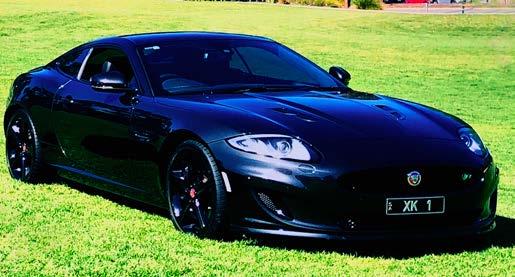
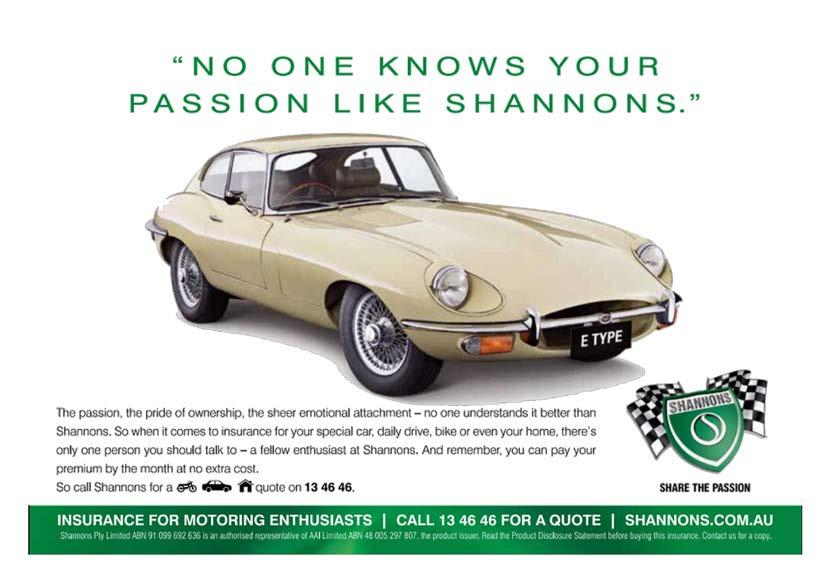

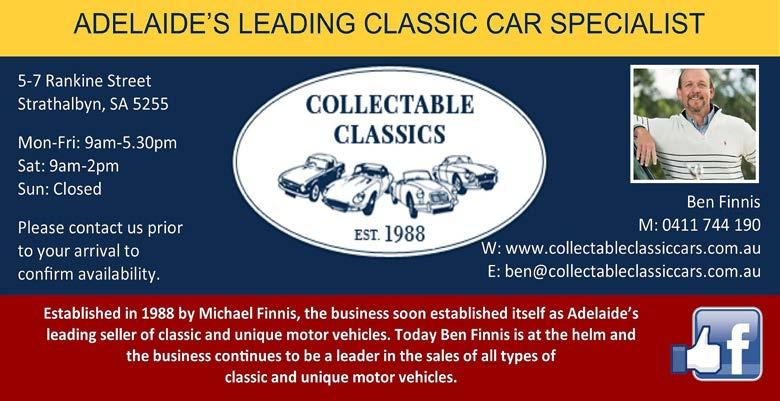


In September 2020 edition of Classic Marque there was a story about the development of the disc brakes and the extraordinary story of Stirling Moss and Norman Dewis. This documentary was filmed 8 years ago but never released. When Sir Stirling sadly passed away at Easter 2020, this brand-new reworking of the project was released so that the story could be told once and for all. However, at the time of writing, the documentary was only available on Sky TV Documentaries.
Fortunately, the 30 minute video is now available on U-Tube.
Called ‘The Racers That Stopped the World’, the documentary cast includes Derek Bell, Sir Jackie Stewart and Murray Walker alongside Moss and Dewis discussing the impact the Jaguar C-Type and its disc brakes made on motorsport. It was back in 1952 that disc brakes were first used in a C-Type, Dewis testing incessantly with Dunlop over the winter and getting a car on the Goodwood grid that spring, with Moss using it to set the fastest lap - making it clear Jaguar was onto something. In 1953 came the C-Type’s crowning moment; with further Dunlop-Dewis testing, the team went to Le Mans. Not only were the C-Types lighter than ‘52, they had improved discs brakes. The result was a one-two for Jaguar, with Tony Rolt and Duncan Hamilton taking the victory and the second placed car piloted by Moss and Peter Walker. It was also the first time that Le Mans had been won with an average speed of more than 100mph. The video goes for 30 minutes, but is a must see. Goto: https://www.youtube.
com/watch?v=OVnyRa79EA0

F-Pace SVR Crowned SUV of The Year
“Driven Women Magazine”, the only motoring magazine of its kind in the world that focuses on women and
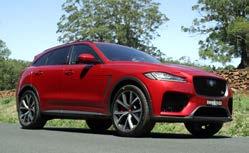
With the F-Pace SVR you are essentially getting twice the number of seats for half the price of the F-Type SVR Coupe.
motoring culture, has awarded Jaguar’s F-PACE SVR the SUV of the Year, stating the decision was “an easy choice”. In the magazine’s 2020 review of the car, the driver hits the start button to be greeted by a sound she is extremely fond of - the roar of the supercharged V8 engine coming to life. She says she has driven a lot of Jaguars in her life, but the F-PACE SVR is her favourite hands down. There are three reasons the reviewer is so taken with the vehicle, the first being that incredible V8 that propels the AWD
from 0-100km in 4.3 seconds, with a top speed of 283kmh. Secondly the spacious, comfortable cabin means she can share the amazing driving experience with her family. And finally, the price of the F-PACE SVR is the most value-for-money Jaguar you can currently buy, which makes it a win in her book. Other highlights include a long list of standard inclusions, the cabin’s luxurious look and feel is a standout, as is the 10” pro infotainment system, and the standard inclusion of Apple CarPlay and Android Auto. .
2021 Formula E Season Kicks off
The seventh season of the Formula E kicked off on February 26/27 in Diriyah, Saudi Arabia. The Formula E is an all-electric single-seater racing series designed to push the boundaries of e-mobility. The whole goal of Formula E is to bring racing and electric vehicle technology to the people. The series races almost exclusively on temporary street circuits in cities like Paris, Berlin and New York, which means it’s a lot easier for the average population to attend an event. The championship consists of 10 teams, each of which has two drivers. The big difference is that practice, qualifying and racing action generally takes place, all in the one day. A few times a year there will be a double-header race format. That means that there will be one day of racing on Saturday, followed by a second on Sunday. The Jaguar Team has previously had 6 podium finishes and two wins. This year’s drivers are Sam Bird and Mitch Evans. News Flash: It is only race 2 of 8, but Mitch Evans finished 3rd in Race 1 and Sam Bird won Race 2. Jaguar now lead the Team Standings ahead of Mercedes. .


